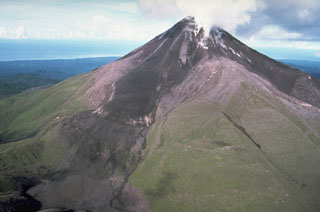Report on Bagana (Papua New Guinea) — September 1986
Scientific Event Alert Network Bulletin, vol. 11, no. 9 (September 1986)
Managing Editor: Lindsay McClelland.
Bagana (Papua New Guinea) Small summit exlosion; rockfall events decline
Please cite this report as:
Global Volcanism Program, 1986. Report on Bagana (Papua New Guinea) (McClelland, L., ed.). Scientific Event Alert Network Bulletin, 11:9. Smithsonian Institution. https://doi.org/10.5479/si.GVP.SEAN198609-255020
Bagana
Papua New Guinea
6.137°S, 155.196°E; summit elev. 1855 m
All times are local (unless otherwise noted)
"The predominately effusive eruption continued, although a decline in seismicity (probably mostly rockfall events from the active lava flow) was registered. Daily totals of volcano-seismic events ranged between 5 and 35, and the month's total was about 500. In August, 10-75 events/day were recorded and the total for the month was 1345.
"One small summit explosion was seen on 9 September. The products of this explosion included lava fragments that were incandescent in daylight. Summit glows were observed on the nights of the 12th, 14th, and 22nd. Emissions from the summit consisted mostly of moderate to strong white vapours or brown-grey vapour and ash clouds."
Geological Summary. Bagana volcano, in a remote portion of central Bougainville Island, is frequently active. This massive symmetrical cone was largely constructed by an accumulation of viscous andesitic lava flows. The entire edifice could have been constructed in about 300 years at its present rate of lava production. Eruptive activity is characterized by non-explosive effusion of viscous lava that maintains a small lava dome in the summit crater, although occasional explosive activity produces pyroclastic flows. Lava flows with tongue-shaped lobes up to 50 m thick and prominent levees descend the flanks on all sides.
Information Contacts: C. McKee, RVO.

